



2023 University Hospitals





2023 University Hospitals

The cover symbolizes the vibrancy, uniqueness and variety of the communities we serve. Just as each brushstroke adds to the overall beauty of a painting, each community contributes to the rich tapestry of our service areas. Three clear priorities – Maternal & Child Health, Well-being and Economic Opportunity – focus our community investment and are interwoven throughout our system, generating significant impact. Reflecting the essence of collaboration and synergy, much like our programs that aim to connect various stakeholders to drive meaningful change, the cover illustrates how we are creating a masterpiece with our community – bringing together different elements and working in harmony. While the colorful strokes symbolize the diversity and individuality of our communities, the shield brings us all together and represents the unified effort required to achieve our goals. When we work together, we can create something truly impactful and beautiful for the well-being of all community members
At University Hospitals, the communities we serve are incredibly important to us. Our dedication goes beyond providing advanced, accessible and compassionate healthcare in our hospitals and clinics. We view our neighbors as part of our extended family, which means we are deeply committed to compassionately caring for them, supporting their overall well-being and addressing their needs in meaningful ways.
Our approach starts with listening. By regularly engaging with community members and leaders, we learn how best to assist and then take action based on their feedback. One avenue includes identifying the most pressing needs through our Community Health Needs Assessments, which evaluate the overall health status of Northeast Ohio, identify critical health-related needs and prioritize services accordingly.
In collaboration with community organizations as well as intentional engagement with residents and stakeholders, University Hospitals focuses on three main priorities for our community health investment: Maternal & Child Health, Well-being and Economic Opportunity.
Since our founding in 1866, University Hospitals has upheld the principle that “the most needy are the most worthy.” As such, we are proud to report that University Hospitals’ community health investment totalled $707 million in 2023.
As the third largest healthcare employer in the state, University Hospitals is dedicated to enhancing economic conditions for all. We achieve this by recruiting, training and hiring local talent; investing in neighborhood health improvement projects, including lead poisoning mitigation, community wellness centers, mobile clinics and paramedicine programs; and partnering with others to foster business growth and create jobs. In fact, our total economic impact in the state of Ohio eclipsed $14 billion in 2023.
Furthermore, we are committed to creating a brighter tomorrow by educating future caregivers, funding medical research that offers hope to those with limited options and launching research studies and programs to alleviate healthcare disparities.
On the following pages, you will see several examples of our community commitment in action. Importantly, University Hospitals’ investment is focused right here in Northeast Ohio.
Your hometown healthcare team thanks you for your ongoing trust and support.
Together, we are building a healthier, more vibrant community.


CLIFF A. MEGERIAN, MD, FACS Chief Executive Officer; Jane and Henry Meyer Chief Executive Officer Distinguished Chair University Hospitals

JOHN G. MORIKIS Chair, Board of Directors University Hospitals
HEIDI L. GARTLAND, MHA, FACHE Chief Government & Community Relations Officer University Hospitals
To Heal. To Teach. To Discover.
Advancing the Science of Health and the Art of Compassion.
Service Excellence Integrity Compassion Belonging Trust
TOTAL: $707 Million in 2023
$185 Million2 Unreimbursed Medicare Costs
UH provides services to many patients who are insured by Medicare and Medicare Advantage payers. Because these payers reimburse at less than the cost of providing care, and at rates set by the government, they typically do not keep pace with inflation, and therefore UH sustains a loss on care provided.
3
Thousands more of our underresourced neighbors now qualify for Ohio’s expanded Medicaid coverage, yet the state and federal health insurance program reimburses providers for only a portion of the care they provide. UH underwrites the remainder of these patients’ bills, reflecting our commitment to our community’s health.
$58 Charity Care
$100 Education and Training4
UH elevates standards of healthcare here and elsewhere by preparing future generations of caregivers. Approximately 1,200 physician residents and fellows train here each year, along with thousands of nurses and other health professionals. We reach into our local community to teach lifesaving techniques and to inspire people to pursue healthcare careers.
Some of our neighbors lack the means to pay for essential healthcare. Throughout our history, UH has always provided care without regard for ability to pay.
$522 Million1 in community benefits was for contribution categories on the IRS Form 990 Schedule H.
$58 Research4
UH serves our community in its broadest sense by engaging in and funding clinical research. In conjunction with Case Western Reserve University School of Medicine and private-sector health care companies, our professionals elevate care standards and develop new ways to diagnose, prevent, treat and cure diseases and injuries.
$38 Community Health Improvement4
Our outreach programs provide no-cost health screenings and help thousands of people understand their health, ways to improve and maintain it, and the resources available to them. We also invest in the community’s health by supporting health-related community causes.
1 UH’s gross community benefit investment under IRS 990 guidelines for 2023 was $663 million.
2 UH estimates these losses based on available information and all estimates are subject to change. UH installed EPIC across all of its business units in the 4th quarter of 2023 and that has introduced volatility in the estimates provided. This loss is in addition to the $522 million Community Benefit spend.
3 Under Internal Revenue Service guidelines, we subtracted $75 million from Medicaid Shortfall to reflect net funding recorded from the state Hospital Care Assurance Program.
4 We subtracted $65 million in restricted grant funding from outside organizations from Education and Training, Research and Community Health Improvement, as required by IRS reporting guidelines for nonprofit hospitals.
To ensure we remain focused and maximize our potential for impact, we established three priority areas: Maternal & Child Health; Well-being and Economic Opportunity. Our community health investment framework is designed to address the needs of those we employ, care for, insure through our Accountable Care Organization and live with in our communities.
& Child Health
Optimize women and children’s health programming, including the expansion of:
• Integrated clinical and behavioral health services
• Social needs navigation
• Centering Pregnancy
• Mobile Community
Enhance well-being programing, including expansion of:
• UH Wellness Center model
• UH Cutler Center for Men
• Behavioral Health initiatives
• Mobile Community Health programs

Boost economic opportunities through program enhancement, including creation of:
• UH Workforce Development Center
• Youth Career Educational initiatives



4,613 patients were screened for social needs at the University Hospitals Rainbow Babies & Children’s Ahuja Center for Women & Children, of which 2,285 screened positive for a need and were provided resource navigation and educational material.
191 women participated in Centering Pregnancy; 57 of whom received intensive, one-on-one support from a mental health specialist.
Maternal & Child Health
Medical Legal Partnership Services handled 198 cases, which affected approximately 671 people.
4,270 people received mammograms via the UH Mobile Mammography Unit.
3,570 children received vision check-ups through UH Rainbow Ahuja Center for Women & Children.
During the 2023-2024 school year, UH and LifeAct provided more than 48,000 students in over 175 schools across 17 counties in Ohio with suicide prevention and stress management education.
134,910 community residents participated in early detection screenings, health education, support groups, fitness programs or health-related events.
1,118 substance use disorder patients connected to peer supporters via Thrive program
4,404 people received food via a Food for Life Market®
3,926 meals were served through the Summer Lunch Program.
26,948 people received a no-charge coronary artery calcium score.
3 Community Wellness Centers opened in the Glenville, Bedford and Richmond Heights communities in 2023.
276 people were hired via community-focused workforce pipeline programs.
Economic Opportunity
50 students participated in the UH Health Scholars program.
300 community members participated in the Future Shades in Medicine Youth Summit.
A commitment to Community Health sounds like a very good thing for a health system to make, but there are no common criteria to prove that commitment.
So when University Hospitals earned prestigious awards on both national and international stages in 2024, it served as validation that we are on the right track with our community health efforts. These accolades affirm our mission to deliver healthcare as a heartfelt commitment to every individual, no matter their background or economic status.
In a standout achievement, UH Cleveland Medical Center was the only Ohio-based hospital named to U.S. News & World Report’s inaugural list of Best Regional Hospitals for Equitable Access. This new category celebrates hospitals excelling in providing high-quality care to historically underserved communities. It’s a testament to our unwavering dedication to the belief that “the needy are the most worthy,” a principle our founders held dear. This recognition underscores our success in serving socioeconomically vulnerable populations, Medicaid beneficiaries, and racial and ethnic minorities with the utmost care and respect.

UH was one of only five honorees this year to earn the American Hospital Association’s coveted Dick Davidson NOVA Award for its innovative Food for Life Market® program. The NOVA Award recognizes hospitals and health systems for their efforts toward improving community health status, whether through healthcare, economic or social initiatives. UH’s Food for Life Market® is a food-as-medicine and food insecurity preventative model that addresses chronic health conditions by providing free, healthy food and dietitian consultation. The program’s goal is to help patients control chronic conditions such as high blood pressure and diabetes. To date, over 8,000 lives have been touched through the program’s five markets since 2018.


At University Hospitals, our community health initiatives are not just programs; they are a promise to create a healthier, more equitable world. These awards affirm our dedication and inspire us to continue leading with love, compassion and an unwavering commitment to those we serve.
UH made its mark beyond the U.S. as well. The International Hospital Federation, which represents healthcare organizations from nearly 70 countries, awarded UH an Honorable Mention in the Leadership and Management Excellence Category. From more than 500 entries, UH was one of only three finalists from the United States.
Undergirding that win was UH’s approach to compassionate patient care: love. In fact, a leader from the American Hospital Association, who supported our nomination, stated:
“When UH speaks of ‘love’ they are really referring to the transformational power that comes from reconnecting healthcare providers to their core purpose. I believe UH has established a culture in which people prioritize always doing the right thing for patients.”
One important way we do that is by creating a diverse and compassionate culture, which promotes equity internally and externally, both in how we care for our patients and the community. Celina Cunanan, UH’s Chief Diversity, Equity & Belonging Officer, helps champion these efforts. In 2024, she was honored as a Diversity Leader by Modern Healthcare, a “Chief Diversity Officer to Know” by Becker’s and received an Excellence in HR award in the Diversity, Equity & Inclusion category by Crain’s.

Part of addressing the region’s high infant and maternal mortality rate means better serving pregnant women across Northeast Ohio who may not be able to travel to a hospital or doctor’s office – those who live in obstetric deserts. These pregnant women not only lack access to obstetricians/gynecologists and midwives, but fetal ultrasound scanning too.
Recognizing this crucial issue, University Hospitals Women’s and Children’s Services has launched a first-of-its-kind mobile obstetrics imaging unit focused on fetal ultrasound in Portage and Lorain counties. The UH Mobile OB Unit was made possible thanks to a significant gift from the Lozick Family Foundation, with additional support from FirstEnergy Foundation, Lincoln Electric Foundation and Sherwin-Williams Foundation.
The UH Mobile OB Unit travels five days per week, giving women in the area access to fetal ultrasounds. On Mondays and Thursdays, the truck is located in the parking lot of UH Portage Medical Center, and on Tuesdays, Wednesdays and Fridays at UH Elyria Medical Center. The truck is staffed with specialty sonographers, and maternal fetal medicine (MFM) experts review the ultrasounds remotely.
“We have been working on bringing this high-quality fetal ultrasound closer to our patients for quite some time and it is exciting to see it finally come to fruition,” said David Hackney, MD, Chief of Maternal Fetal Medicine, UH Cleveland Medical Center. “The flexibility and efficiency of the unit will allow our experts to care for more women during pregnancy and fill gaps in access to care.”
“Throughout the country, and also in Northeast Ohio, health risks of pregnancy like high blood pressure and pre-term birth have been rising. Expert prenatal care, including fetal imaging, can help address this trend.” – David Hackney, MD
MFM imaging is a specialized diagnostic process used during pregnancy to enhance safety for the mother and provide reassurance regarding fetal well-being. Expectant moms should receive two to three ultrasounds during their pregnancy, providing critical information to OB/GYNs, such as the baby’s heartbeat, position, estimated due date and any potential complications or anomalies.
“Too many of our patients do not have access to critical prenatal care and maternal fetal medicine imaging in their communities,” said Dr. Hackney.
“It is our mission to ensure more women receive the expert imaging they need to give birth to a healthy baby safely and confidently.”




Caries is a term dentists use to describe tooth decay. Severe early childhood caries, formerly known as Baby Bottle Tooth Decay, is a significant public health problem. In Ohio, about half of school-aged children have a history of tooth decay, according to the Ohio Department of Health. And it’s a problem that overwhelmingly affects kids from under-resourced areas, who are less likely to receive regular dental care.
“University Hospitals Rainbow Babies & Children’s Hospital is the safety net for children in all of Northeast Ohio,” said Kelly Kirtland, DDS, Chief of Pediatric Dentistry, UH Rainbow Babies & Children’s.
“Approximately 94% of the children we treat are covered by Medicaid and often struggle with social determinants of health, such as food, housing, financial and transportation issues. Many also have complex medical, dental and behavioral needs.”
That’s why in 2010 UH Rainbow Babies & Children’s launched the Ronald McDonald Care Mobile®, a 43-foot-long full dental clinic on wheels that provides on-site care to children ages 3 to 12 from underresourced neighborhoods. It was launched with the generous support of Ronald McDonald House Charities of Northeast Ohio and McDonald’s Restaurants of Northeast Ohio.
“Our
partnership with UH Rainbow Babies & Children’s for hospital-based and community programs is essential in helping us remove barriers and improve access to healthcare for families,” shares Craig Wilson, CEO of Ronald McDonald House Charities® of Northeast Ohio.
“The Ronald McDonald Care Mobile partnership delivers dental care and education to help children stay healthy and avoid the devastating health effects of childhood tooth decay – the #1 chronic childhood disease in America,” said Wilson.
The Ronald McDonald Care Mobile travels to various community events and our annual Give Kids A Smile Day event to provide routine dental screenings and cleanings along with treatment options such as filling cavities, extractions, pulp therapy and placing crowns. It is staffed by board-certified, attending pediatric dentists, the Case Western Reserve University pediatric dentistry residents, pediatric dental hygienists, and pediatric dental assistants, who are experts in the unique needs of children.
One such community outreach event took place in August 2023. The event was organized by Matrice Perry, Patient Experience Manager at UH TriPoint and UH Lake West medical centers, and Anita Thomas, a dental assistant with the Ronald McDonald Care Mobile unit, at the Fannie M. Lewis Community Park in Cleveland to help prepare children for the upcoming school year.
“It was important to bring the Ronald McDonald Care Mobile to a place familiar to the community and bring awareness to the importance of dental health by providing on-site dental cleanings to under-resourced children,” said Ms. Perry. “Compassion is being willing to meet the needs of people wherever they may be.”
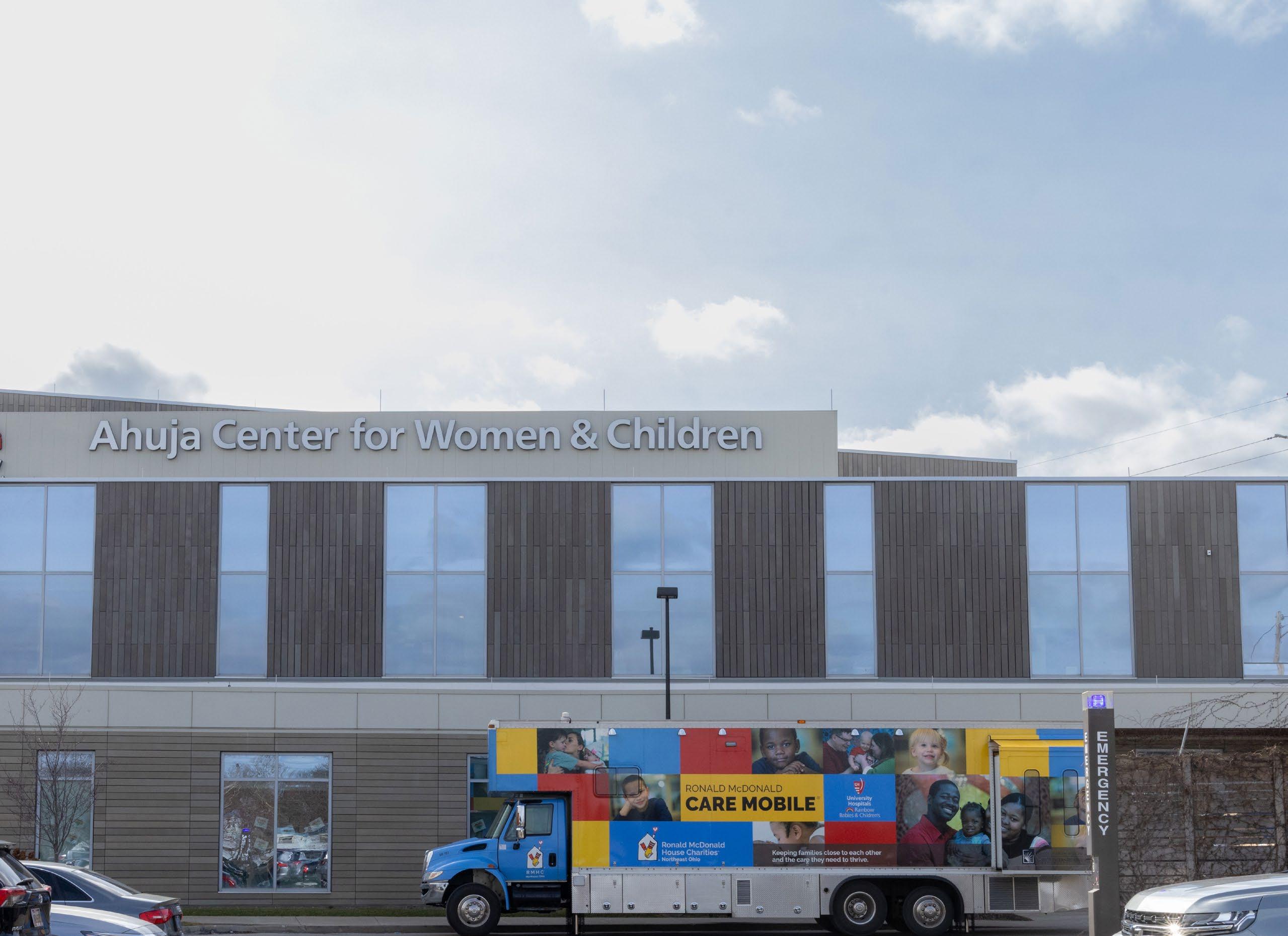

Children, especially those with special healthcare needs like craniofacial malformations, complex medical conditions and those requiring routine pediatric dental care in the most child-friendly environment, will soon have a state-of-the-art pediatric dental home they can call their own – the University Hospitals Rainbow Babies & Children’s Hospital Smile Suite.
Located on the first floor of UH Rainbow Babies & Children’s, the Smile Suite is the result of a generous gift from local philanthropists as well as funding from the state of Ohio and the Delta Dental Foundation.
The Smile Suite is also ideally suited to provide care for children with developmental and behavioral conditions such as autism and ADHD, as well as those who suffer from facial-skeletal deformities, traumatic facial injuries, cancer or congenital conditions.
“We are thrilled to soon bring a full-service pediatric dental care clinic back to our main campus,” said Patti DePompei, RN, President of UH Rainbow Babies & Children’s and UH MacDonald Women’s hospitals and Rainbow Babies & Children’s Foundation Chair in Leadership and Innovation.


“The Smile Suite will help to address a tremendous need in our community and beyond for high-quality pediatric dental care, especially for children with complex conditions.”
– Patti DePompei, RN
Highlights of the new space include a state-of-theart cone-beam computerized tomography machine, a digital intraoral scanner and a 3D printer. All work to aid in the treatment of infants with cleft lip/palate to create naso-alveolar molding appliances for babies who need them. Additionally, the suite houses special monitoring equipment for any pediatric sedation needs.
“Our pediatric dental team at UH Rainbow Babies & Children’s is uniquely experienced in providing dental care to patients with special healthcare needs and behavioral challenges,” said Kelly Kirtland, DDS, Chief of Pediatric Dentistry, UH Rainbow Babies & Children’s. “We hope this beautiful new space helps bring comfort and alleviate anxieties for the children and families we serve.”
As part of its Community Health Investment Strategy, in 2022, University Hospitals committed $1.2 million to the Lead Safe Cleveland Coalition, the public-private partnership that was formed to address and prevent the issue of lead poisoning.
Exposure to lead is especially dangerous to children because their brains are in critical development stages, and lead exposure can lead to adverse health effects, including slowed growth and development; learning and behavior problems; hearing and speech problems and lack of appetite.
Through our support, the Lead Safe Cleveland Coalition has achieved these results: Over 29,000 rental units have achieved lead-safe certification, 384 lead-safe workers – individuals who receive specific training to help homes and properties in Cleveland become lead safe – have been trained, and 500 units are anticipated to be remediated in 2024. The Lead Safe Cleveland Coalition is also significantly invested in continuing to raise awareness about the dangers of lead hazards and the resources available to address them, hosting and participating in over 275 lead education trainings and events to reach property owners, renters and the general public.
“Health and housing are inextricably linked, especially when it comes to keeping children safe from lead hazards in the home.”
–
Wyonette Cheairs, Program Director at Enterprise Community Partners, which manages the Lead Safe Cleveland Coalition.


Olushola Fapo, MD, University Hospitals pediatrician
“We’re so thankful to partner with healthcare institutions like University Hospitals. Their significant investment in the Lead Safe Home Fund helps us make more homes lead-safe as we work to ensure every child in our community can grow up in a safe and healthy environment,” said Cheairs.
As a system, UH is working to improve testing rates of all children at risk for lead exposure, especially at UH Rainbow Babies & Children’s Ahuja Center for Women & Children. “Children should be checked for lead at their one-year and two-year well-child visit or if they are between the ages of 3 and 6 and have never been tested and live in high-risk Zip codes or on Medicaid,” said Olushola Fapo, MD, a University Hospitals pediatrician. “What we found as a result of our recent transition to the Epic electronic health record is that nearly half of the patients who came to the UH Rainbow Babies & Children’s Ahuja Center for Women & Children for their well-child visits since the beginning of this year did not complete the ordered lead testing. And that’s really concerning.”
The good news though is with Epic, UH is now able to pull better data so that we can track and monitor patients. “Epic now allows us through MyChart or the Rainbow Connects team to reach back out to parents of patients who haven’t completed their testing or whose children initially tested with elevated lead but have not been back for retesting,” said Dr. Fapo. “Epic also includes a health maintenance checklist which acts as a reminder to physicians to order the recommended lead test and start counseling parents of children early, even as young as 6 months, on lead prevention strategies.”
The next step, according to Dr. Fapo, will be to develop a Care Management module in Epic to help with providing wraparound care.
Cuyahoga County faces a grave challenge with one of the highest infant mortality rates in Ohio, disproportionally affecting Black babies and mothers. David Hackney, MD, Chief of Maternal Fetal Medicine, UH Cleveland Medical Center, emphasizes the growing complexity of pregnancies, with many expectant mothers dealing with health issues like high blood pressure and diabetes.
“Our pregnant patients are increasingly facing complex health challenges, which underscores the need for specialized care,” said Dr. Hackney. “The demand for high-risk obstetricians specializing in maternal fetal medicine (MFM) far exceeds the current supply across the nation.”
Recognizing this need, UH has collaborated with the MetroHealth system since 2017 to train new MFM specialists through a combined fellowship program. Fellows spent time at both institutions, gaining diverse and comprehensive experience. In the summer of 2024, UH launched its own independent, single-institution MFM fellowship alongside MetroHealth and Cleveland Clinic, who also offer their own independent MFM fellowships.
This initiative aims to harness the unique strengths of each health system, ensuring MFM fellows receive the best possible education from leading experts in their field. For the 2024-2025 academic year, the three institutions plan to enhance collaboration with quarterly combined education sessions, with an eye toward more robust collaboration in 2025 and beyond.
UH MFM fellows will engage in both direct clinical care and research, both of which are needed, said Dr. Hackney. They’ll provide much of their clinical care at the UH Rainbow Babies & Children’s Ahuja Center for Women & Children, which serves an acutely under-resourced area. The center offers Centering Pregnancy, a group-based model of prenatal care, as well as a diabetes clinic for pregnant patients with gestational diabetes. The fellows will also be involved with the new mobile obstetrics imaging unit that UH launched to serve Portage and Lorain counties.
“By creating our own independent single-institution fellowship, University Hospitals is leading the way in training the next generation of maternal fetal medicine physicians who will help us move the needle in addressing pre-term births and improving outcomes for mothers and babies in our community. ” – David Hackney, MD
This fellowship program symbolizes a united effort to bring hope, support and advanced care to those who need it most, fostering a sense of community and compassion for all.
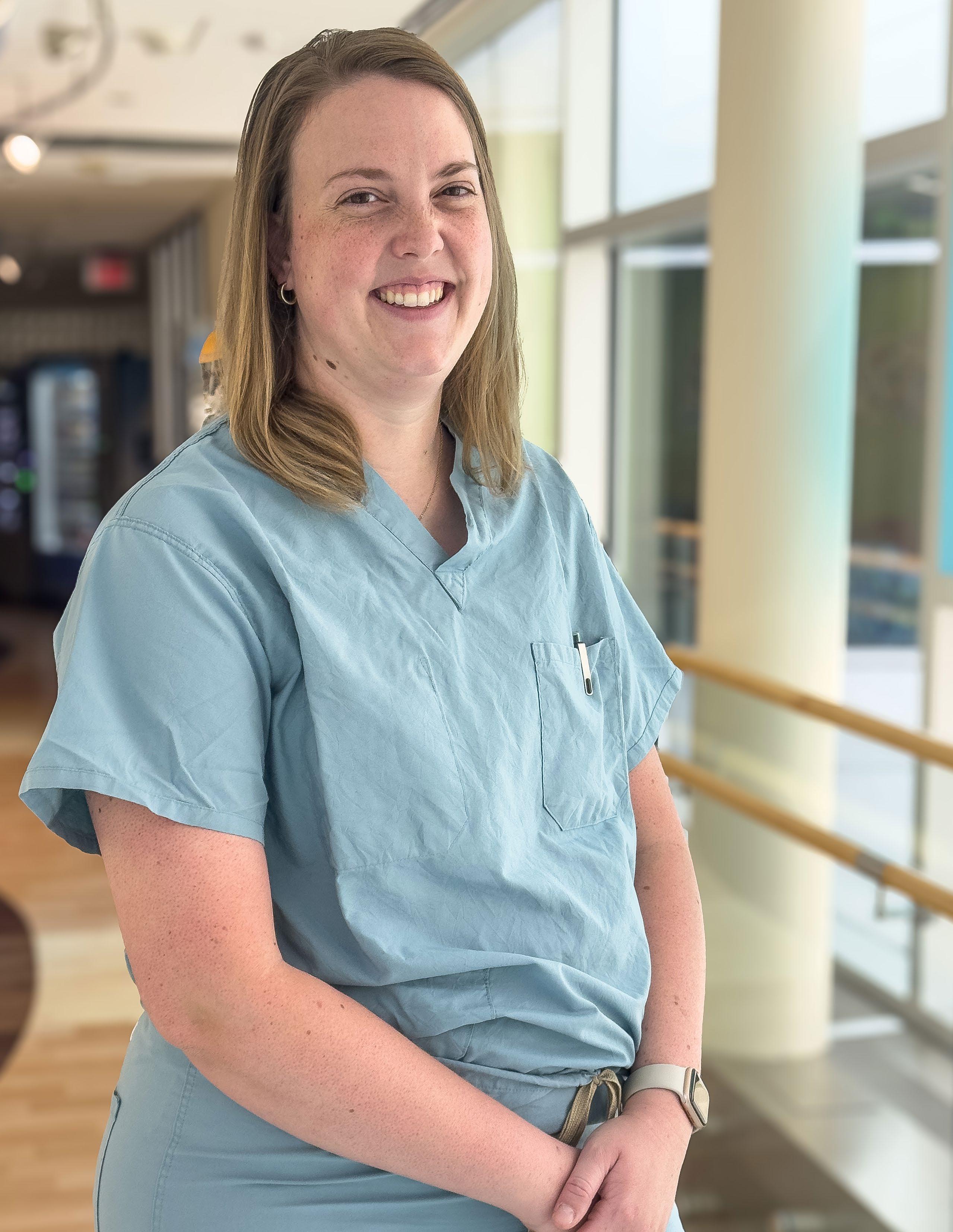
Imagine walking into a wellness center that not only promotes healing but also embodies the vibrant spirit and culture of its community. University Hospitals has achieved this vision by integrating local artwork into our wellness centers, transforming them into culturally rich sanctuaries. This innovative approach not only enhances the wellness experience but also showcases the work of local artists. At UH’s Bedford and Glenville community wellness centers, which are located in predominately Black communities in Greater Cleveland, installations by Black artists celebrate and reflect the community’s unique fabric, offering both aesthetic beauty and a sense of belonging.
The mission of the UH Bedford and Glenville community wellness centers is to address social determinants of health and enhance the well-being of communities through trust building, health education, wellness programming and health screenings. These centers are designed to be community hubs where people can come together to improve their overall health and wellness.
“Our goal with the wellness centers is to have a clear distinction from the traditional clinic or medical building. Walking into the space to receive community health programming, we wanted people to instantly feel welcomed and inspired and knew art would provoke those feelings.”
– Lena Grafton, PhD, MPH, CHES, Director of Community Health Engagement
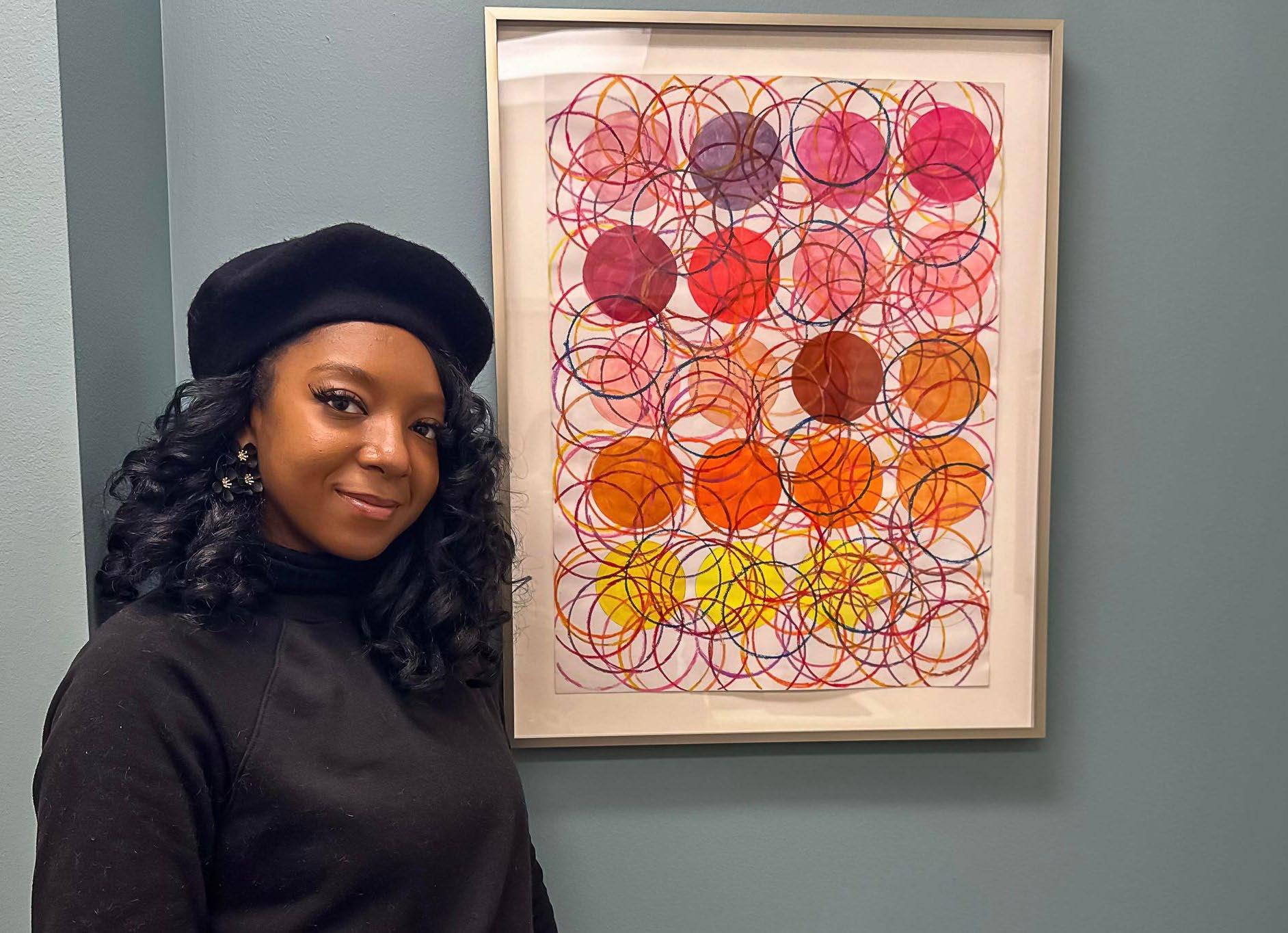
The displays at the wellness centers not only create culturally rich environments but also align with UH’s broader Community Health Investment Strategy. By purchasing art from local artists, UH is generating economic opportunities for these artists, helping to support the local economy and promote cultural expression.
UH has a long-standing tradition of emphasizing the importance of art in its medical centers. Tom Huck, the Jackie and Fred C. Rothstein, MD, Endowed Director of Art Curation, has been UH’s art curator since 2011.
“We knew we wanted to feature local Black artists, but we tried to think outside the box about how we could take that even further,” said Huck.
To bring this vision to life, UH representatives coordinated with David Ramsey at Deep Roots Experience art gallery in the Fairfax area. Together, they selected 21 pieces of art from nine different artists, ensuring that the artwork
resonated with the themes of the wellness centers, such as healthy eating and community. This process took about six months of careful planning and selection.
“Investing in living artists is the only way that art continues,” said Ramsey. “As people see the artwork, we hope they’re inspired to invest in pieces for their own homes, which supports artists and art in general.”
By integrating local art into our wellness centers, UH is not only creating beautiful, welcoming spaces but also fostering a deeper connection with the community. This initiative exemplifies how healthcare facilities can go beyond traditional medical care to address the broader social determinants of health and well-being.
The artists represented at the wellness centers are: Aldonte The Artist, Asia Armour, Bee1ne, Jae Capo, Dayzwhun, Pahpy@sammiedoesit, Bobbi Reagins, Vivica Satterwhite and Emanuel Wallace.
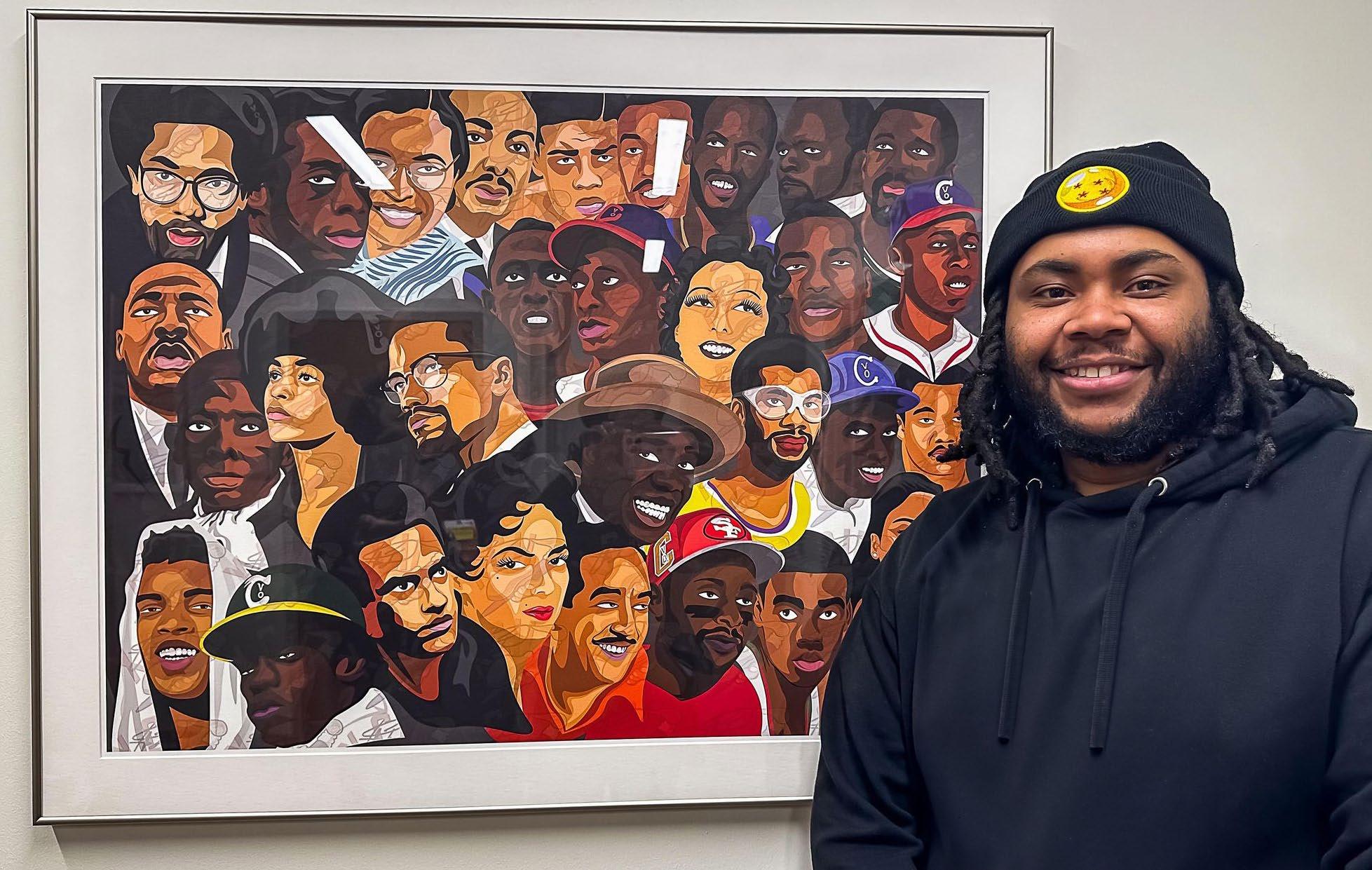
Residents of Richmond Heights now have a new resource for staying safe, healthy and out of the hospital. In 2023, University Hospitals, in collaboration with the city, launched a Community Paramedicine Program to improve the area residents’ overall health and well-being by providing skilled healthcare in the home.
Building on the success of similar programs in Lakewood and Kent, UH helps residents prevent illnesses and accidents, teaches them how to manage complex chronic health conditions and connects them with the necessary resources to improve their overall health outcomes.
Through the Richmond Heights Community Paramedicine Program, a paramedic visits residents directly in their homes and provides a wide range of services, including home safety assessments, social services resources and post-hospital release follow-up care.
“The community depends on the 9-1-1 system, but in some cases, they may not need a trip to the hospital,” stated Marc Neumann, Richmond Heights Fire Chief. “Instead, they may need outreach, fall prevention and assistance coordinating where to go for their medications or how to administer them. Fire is only about 25% of what we do. The other 75% is emergency medical services, so this program is about thwarting the incidents before they occur and getting our residents the help they need to be more independent in their homes and the community.”
As part of this community commitment, UH provides medical oversight, clinical protocols and quality review. Tony Daher, MD, a UH emergency medicine specialist, serves as the program’s medical director. “Healthcare overall is increasing its services in the outpatient setting,” noted Dr. Daher. “We also know patients are more comfortable in their home. So when we can visit these residents in an environment that’s more pleasing to them, we will get a more real world assessment than if we saw them in the hospital.”
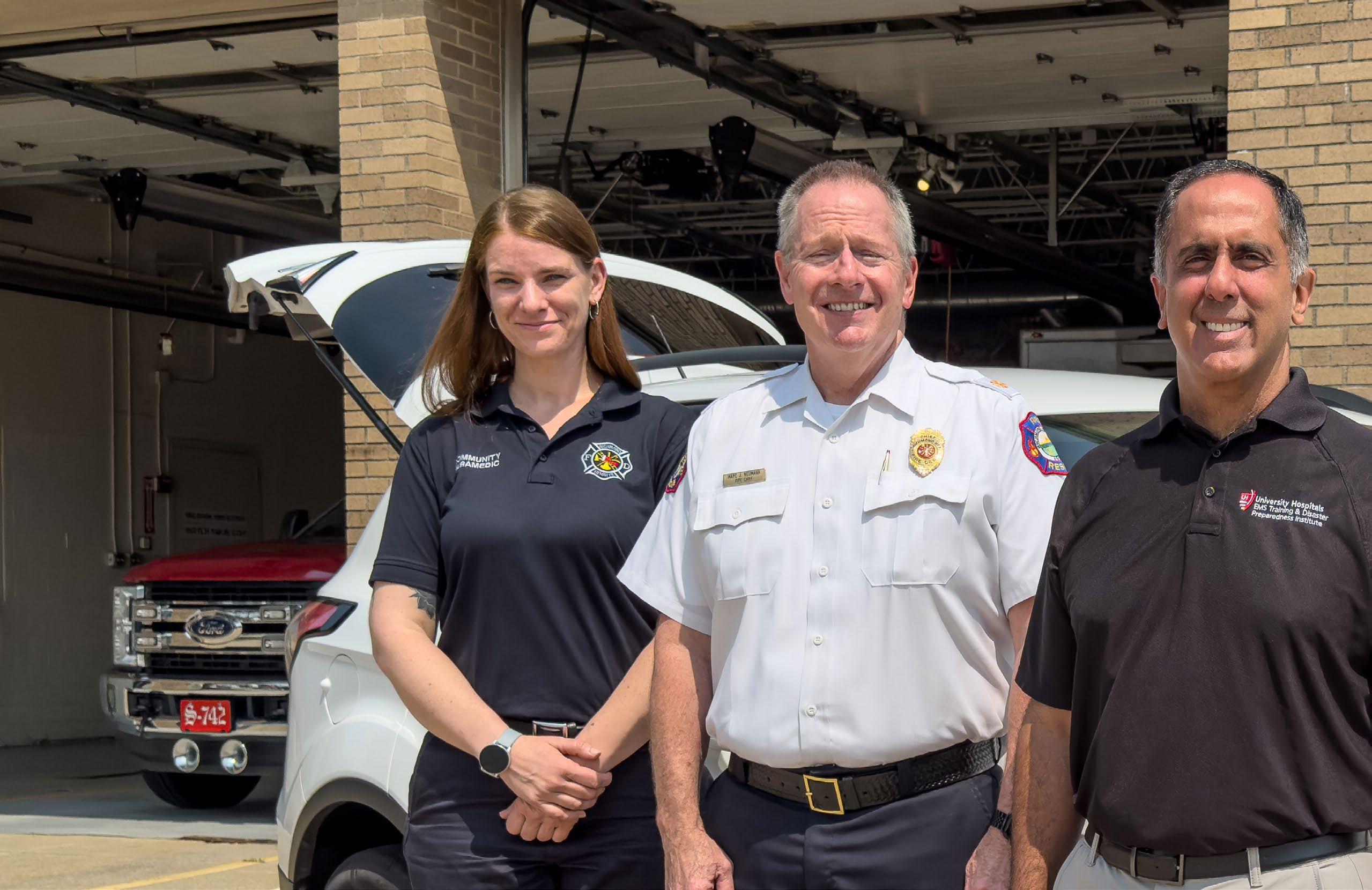
In fact, the paramedic sworn in to serve the Richmond Heights community hails from UH’s own paramedic program. “Nicole has the perfect blend of skills-based training and knowledge of the UH system that will serve our community well into the future,” explained Chief Neumann.
“We are proud to support the rapidly evolving field of Community Paramedicine that is individual-centric to serve our residents best,” said Richmond Heights Mayor Kim A. Thomas. “This proactive health model not only assists residents, but it helps save money and avoids unnecessary strain on our first responders, emergency rooms and other care partners by aiding people in their homes.”
While planning for a physical location is underway, UH further demonstrates its commitment to the Richmond Heights community through a virtual UH Richmond Heights Community Wellness Center, which offers a wide range of health and wellness programs and services to the community. These include biometric screenings, a walking club, health education sessions and a Q&A with a registered dietitian. Since commencing operations in 2023, the UH Richmond Heights Community Wellness Center has served nearly 600 residents.


It’s not every day you hear the words “thriving” and “substance abuse” together in one sentence, but thanks to the Thrive program, UH is connecting patients with peers who have walked in their shoes and empathize with their struggles. Through Cuyahoga County opioid settlement dollars with funding from the Alcohol, Drug Addiction and Mental Health Services Board, the Thrive program has provided support for patients with substance use disorder (SUD) since launching in 2020.
“Too often, patients who come to the hospital with complications related to SUD are on their own to find and follow up with services after they are discharged,” explained Jeanne Lackamp, MD, Chair, UH Department of Psychiatry. “This can lead to numerous complications such as lack of treatment, recurrent use and even overdose or death.”
What makes the Thrive program so effective is that the patient, if they so choose, is immediately connected to a peer supporter who helps them get the necessary care. “Thrive teammates have previously struggled with SUD themselves, so they can relate on a very personal level to what the patient is experiencing,” continued Dr. Lackamp. “The feedback we’ve received from patients has been extremely positive. To date, we’ve connected more than 3,400 patients to peer supporters via this program.”
Notably, in 2023, UH expanded its impact by facilitating Thrive’s connections with patients on select inpatient medical/surgical floors. “Some patients were too sick for us to appropriately connect in the ED, so we created a plan to meet with them in the hospital when they are physically doing better,” explained MacKenzie Phillips, Senior Director of Project & Program Management at Thrive Peer Recovery Services. “It gives us another opportunity for impact.”
“Connecting with patients while in the hospital, and identifying resources to help them take that step toward recovery, greatly improves their chances for success,” noted Justin Larson, a peer navigator at Thrive. “Helping my fellow brothers and sisters in recovery is the bright spot of my life today. I feel supported by Thrive and UH to be my authentic self, which lends to using my lived experience to build trust and offer hope to those struggling with SUD.”
The Thrive program is now in place at all UH emergency departments in Cuyahoga County, as well as select medical/surgical floors at UH Cleveland and UH Parma medical centers.
“In 2023, we connected 82% of our community members coming into our EDs with SUD with a Thrive peer supporter,” Dr. Lackamp concluded. “I am thrilled that UH has partnered with Thrive to support our patients with SUD.”

“Having dedicated Thrive partners working alongside our compassionate UH caregivers truly means that our patients are getting the best chance for success after discharge.”
“When I couldn’t hear my granddaughter tell me ‘I love you,’ I knew it was time for me to get a hearing aid,” recalled David M. Rosenberg, MD, MPH, a pulmonologist at University Hospitals and the co-founder of Hear in Cleveland. “Experiencing the joy in restoring my hearing to an optimal level, and learning that so many in our area don’t have the means to even get their hearing checked, let alone purchase hearing aids, I saw an opportunity to do something about it.”
In collaboration with the Hearing Missions Foundation and the Centers for Hearing Care, Hear in Cleveland launched in 2023, providing needed hearing devices to underserved individuals who are uninsured/underinsured living in the city of Cleveland and surrounding under-resourced areas. UH serves as a hub partner for the program with our otology specialists and residents offering medical care for these community members’ otolaryngologic needs.
“While the goal is to have a dedicated location where audiology care together with wrap around services can be provided, today we have been caring for individuals at various community events, such as the Homeless Stand Down,” noted Dr. Rosenberg. During the event, the UH team provided exams and ear cleaning to about 60 individuals. “The smiles and thank you’s for our compassionate care served as proof we are making a difference.”
“Unfortunately, people with hearing loss often become isolated, which leads to anxiety and depression,” explained Fortunato Figliano, CEO of Hearing Missions Foundation and co-founder of Hear in Cleveland.
“In Cuyahoga County alone, it’s estimated, there are approximately 40,000 people who live below the poverty line and have hearing loss. When you factor in the working poor who also can’t afford hearing devices, we realized the true scale of the issue we were addressing.”
– Fortunato Figliano
“The journey of Hear in Cleveland is a testament to the power of community and collaboration, and we greatly appreciate the partnership and commitment from University Hospitals,” noted Mr. Figliano.
Through the combined efforts of dedicated professionals and compassionate volunteers, the initiative is bringing hope and connection to those who need it most. As Hear in Cleveland continues to grow, the promising future draws closer to reality where everyone, regardless of their financial situation, can experience the simple yet profound joy of hearing a loved one’s voice.



The COVID-19 pandemic prompted hospitals to think creatively about bringing people out again for cancer screening and education. University Hospitals connected with Cleveland Clinic and Mercy Health in Lorain County to collaborate on an event filled with screenings and important health information. United Against Cancer first took place in Elyria in 2022 and moved to Lorain in 2023. Participating guests could view an enormous heart and brain explaining their functions and actually walk through a giant inflatable colon to see why removing polyps through a colonoscopy is so important to tackle cancer. UH brought 3D mammograms onsite through its Mobile Health Unit and performed cholesterol, glucose and blood pressure screenings.
“We started this journey in 2022 and plan to continue it annually to demonstrate that while residents may go to different hospitals for their care, we are United Against Cancer. We want them to know we are brought together in the best interests of health.” – Paul Forthofer, Community Outreach Manager

Every 40 seconds in America someone has a heart attack. But a simple noninvasive test – offered at no charge by University Hospitals Harrington Heart & Vascular Institute – can predict a person’s risk of cardiovascular death, heart attack or stroke over the next 10 years. Since 2017, UH has performed more than 150,000 of these coronary artery calcium score tests for any adult who wants a clearer picture of their cardiovascular health. At other hospitals, the tests can be costly and are generally not covered by insurance. UH performs more than 100 cardiac CTs per day at 29 radiology sites across Northeast Ohio. In 2023, 26,948 people received a no-charge coronary artery calcium score.
WKYC’s senior health correspondent Monica Robins had her own calcium score test broadcast live on TV in 2024 to educate the public about this easy and important test. Her scan was performed in UH Harrington Heart & Vascular Institute’s Center for Advanced Heart & Vascular Care, one of the first cardiovascular centers in the world to co-locate an MRI,
CT and robotically operated cardiac catheterization laboratory with surgical capabilities in the same suite. Sanjay Rajagopalan, MD, UH Harrington HVI’s Chief of Cardiovascular Medicine and the Herman K. Hellerstein, MD Professor of Cardiovascular Research, explained Monica’s results to her in the Advanced Cardiovascular Imaging Center.



Juvens Niyonzima could hardly have moved to Cleveland from Africa at a worse time. It was early in 2020, right before COVID-19 closed nearly everything.
Niyonzima had been a videographer and graphic artist in his native country, the Democratic Republic of Congo. But war and violence led him and thousands of others to flee to Sudan, where he lived in a refugee camp.
So, pandemic uncertainty aside, he was happy to be living in Cleveland – and even happier when he was hired in May 2020 by UH Cleveland Medical Center. At first he worked in Environmental Services (EVS), then, after eight months of training, he transferred to a lab to work in specimen processing.
Being hired by UH, he said, “was the best opportunity I ever received in my life.”
That he and other refugees, most of whom spoke little or no English, could find employment so quickly is due to the collaboration of UH Cleveland Medical Center with the Ohio chapter of the U.S. Committee for Refugees and Immigrants (USCRI).
The collaboration fills a crucial need for UH – one that also was worsened by the pandemic – especially for employees who work in EVS and Nutrition Services, explained Eranga Mendis, Operations Manager for Patient Services in Nutrition, who helped create the partnership between UH and USCRI.
“Historically here at main campus, we’ve had challenges with employee retention and productivity,” said Mendis, who is himself an immigrant and came to the U.S. from Sri Lanka in 1988.

“I was thinking out of the box and I remembered a partnership in which my church sponsored a few families from Ethiopia and Serbia and helped them resettle.”
Mendis searched online, and USCRI and its mission quickly came up. After a few calls and meetings, the process of connecting refugees with jobs at UH was underway.
The transition from refugee to employee can seem daunting, Mendis noted, with many learning to speak English – or better English – on the job. Also, a number of them have not encountered such things as electrical appliances and computers before, which creates another learning curve. USCRI’s occupational therapists work with the new employees on overcoming such challenges.
However, explained Sarah Watson, Nutrition Services Operations Manager for UH Cleveland Medical Center’s Lerner Tower & UH Seidman Cancer Center, the new employees have an immense work ethic, are eager to learn, and are loyal to UH – an employer that provides benefits as well as educational opportunities and promotions. Nyonzima, for example, is a part-time student at Kent State University, where he is studying for a degree in social work. Because of his job, he also has been able to buy a home in East Cleveland, as well as a car.
Mendis and Watson said about 150 refugees have come to UH Cleveland Medical Center to work since the program began in 2018.
“UH means a lot to me and my entire community of refugees. So many are being hired, and the managers work hard to help us become successful in these jobs. UH has given us something very powerful that is changing so many people’s lives.” – Juvens Niyonzima
Lisa Pointer and Sarah VanSickle are two Northeast Ohio residents whose lives were dramatically changed by University Hospitals.
Not because they were patients, but because UH and its collaborative programs helped direct and train them to become caregivers – and to be paid while doing so. Lisa and Sarah are two of several hundred people who have been drawn to UH for employment or advancement in recent years.
Communities also benefit from the opportunities UH provides –being employed, after all, is a social determinant of health. But UH and its patients gain too by having compassionate caregivers who have found their calling, in ways they might never have imagined.
Sarah VanSickle had been a receptionist at a UH medical office in Middlefield Village for three years, after many years of working in various customer service jobs. She enjoyed her UH job and the atmosphere of a medical office, and a few of the providers she worked with encouraged her to get her certification as a Medical Assistant (MA).
“They saw more potential in me than I saw in myself,” she recalled. “I had thought about looking at outside programs before, but ran into the problem of paying for the course, working full-time and going to class too.”
But through one of UH’s Earn and Learn programs, offered in partnership with NewBridge, she was able to continue working full-time while going to school. Since early 2024, she has been an MA at the same office. “I love being an MA where I feel comfortable and supported,” she said. “I would never have been able to accomplish this without the Earn and Learn NewBridge program.”
Sarah was even selected as the student speaker for the class graduation, noted Adrianne Shadd, Manager of Workforce Development and Outreach at UH.
“She spoke of the education challenges that she had while growing up and how that impacted her and her family dynamics,” said Adrianne.
Sarah’s husband, Bobby VanSickle, was impressed, and he is now in the same MA certification program.
“He is doing so well, and I thank UH for this opportunity for our family,” said Sarah.
NewBridge is a Cleveland non-profit that provides the structure and training for the “Earn and Learn” program that Sarah participated in; it offers healthcare training in medical assisting, sterile processing and phlebotomy. Six student cohorts of 18 students each from UH have already graduated from the Earn and Learn MA program, noted Maya Lyles, Chief Operating Officer of NewBridge.
The selected students are placed into a medical assistant trainee role at various UH medical offices for 10 months while they complete the required classroom, lab and externship hours. They are paid to go to school three days a week, as well as for the additional two days they work at the medical office gaining hands-on training, practicing clinical duties and providing much needed support to the host medical staff.
“Our Earn and Learn program gave me another chance at a career, but also the ability to go to school while earning a wage – that was key to providing my family stability.” – Sarah VanSickle

Another UH Workforce program made all the difference for Lisa Pointer and her children. Her husband died from COVID-19 in 2021, not long after the couple’s twins were born. Lisa once had a thriving career in the mortgage banking industry before the economic collapse of 2008. Then she’d worked in management at a JC Penney, until that store closed, then looked for other jobs again.
Professionally, she was at a loss. Yet she knew she wanted a position that fit her caring nature.
By late 2021, she’d run through her savings, was living in an Orange Village motel with her children, and relying on four to five buses a day for transportation to classes at Tri-C, while her mother and friends watched her children. Then, through a friend from church, she learned about the Health Care On-Ramp Program facilitated by Towards Employment, a healthcare collaboration among UH, Cleveland Clinic and MetroHealth designed to lead Clevelanders to healthcare jobs.
Soon, Lisa met a recruiter from UH. Noting her skills and experience, the recruiter thought Lisa would be an excellent community health worker, and so she was selected to join the UH Community Health Worker Earn and Learn program, where she earned her state certification.
A few months later, she was asked to be a clinical data assistant in the ED at UH Cleveland Medical Center. Last September, Lisa was promoted to supervisor of a 26-member Community Health Worker team.
“The connection with Towards Employment was so valuable,” said Lisa. And despite all the challenges she faced in the past four years, she is grateful to be doing the kind of work she believes she was meant for.

“All roads led me here.”
– Lisa Pointer
Clinical rotations are a critical part of a nursing student’s education. UH partners with local nursing schools to welcome their students into our hospitals, and we estimate that one-fourth of them will choose UH for their career. In 2023, our undergraduate clinical placement team helped assign more than 5,100 nursing students into clinical rotations and more than 600 students with preceptors. With such a big program, it is impressive to note that UH has earned a reputation for being the easiest, most efficient health system in the area for nursing students and clinical instructors to onboard. The secret to our success: our culture and bedside caregivers.
One nursing student commented, “UH just feels like home.” She smiled and continued, “Yesterday, a doctor talked to me, and I was nervous to tell him that I was a nursing student. Instead, he explained things even further.”

For nearly 160 years, University Hospitals has been guided by a strong commitment to civic and social responsibility, leveraging its role as an anchor institution and Northeast Ohio’s hometown team to build physical and economic health for the community.
Silverlode Consulting Corp., recently conducted a study showing that UH contributed $14.3 billion to the regional economy in 2023, an increase of 38% since 2019
In fact, UH generated more than $6 billion of labor income in the state of Ohio and supported more than 37,0001 direct jobs in Ohio in 2023. In turn, these direct jobs fueled more than 41,000 indirect and induced jobs, resulting in a total of 78,668 Ohio jobs supported by the system in 2023.
The average annual per person earnings of the direct system jobs in Ohio, including benefits, was 1.4 times the statewide average. These jobs and the associated earnings sustained more than 53,000 Ohio households, which spent approximately $4.8 billion purchasing goods and services in the state.
Although UH is a not-for-profit organization, the system’s operating and construction activities resulted in the generation of $466.2 million of state and local taxes in 2023.
“At UH, we take immense pride in our role as an anchor institution,” said Heidi Gartland, UH Chief Government & Community Relations Officer. “Our commitment to fostering economic growth and community well-being has driven us to achieve a remarkable $14.3 billion contribution to the Ohio economy in 2023. This milestone underscores our dedication to not only being the hometown team, but a transformative force for good, supporting tens of thousands of jobs and uplifting countless households across the region.”
While all of UH’s direct operational and construction activities occurred in Ohio in 2023, an additional $2.3 billion in impact was made across the country from indirect and induced activities such as purchasing goods and services from companies located out of the state. In total, University Hospitals produced $16.6 billion in economic output for the United States in 2023.

In May 2023, University Hospitals joined 16 other health systems in the country in signing an “Impact Workforce Commitment” and in doing so, pledged to identify opportunities to increase the hiring, training and promotion of diverse talent.
This was done through a program designed by the national Healthcare Anchor Network, which partnered with the National Fund for Workforce Solutions.
Since then, UH has far exceeded its commitment in hiring, said Kim Shelnick, Vice President of Talent Acquisition at UH.
“Our goal was for 10% of our hires to come from economically disadvantaged Zip codes,” she explained. “Yet in 2023, we hired 871 people from these areas, and that is about 25% of our total hiring from Cuyahoga County.”
Those 871 hires represented an 18% increase from the year before. Also, noted Shelnick, 88% of the people hired were from minority populations.
Besides filling jobs at UH, the Impact Workforce Commitment aims to improve social determinants of health to create economic opportunities and address racial and health inequities in the communities we serve. It is specifically designed to attract people who may have previously faced employment barriers because of a lack of access to education and training, or other socio-economic challenges.
“Our workforce development philosophy aims to connect residents from Northeast Ohio to jobs in which they can develop their professional potential and increase aspirations, increase their earning potential, and help move their families out of poverty.”
– Kim Shelnick

A remarkable clinical trial that effectively erases sickle cell disease is bringing new hope for those suffering from a painful disease that disproportionately affects African American and Latino people.
The investigational therapy treatment at University Hospitals Rainbow Babies & Children’s Hospital uses gene-editing CRISPR technology to modify the patient’s own cells and reintroduce the modified stem cells back into their body. The goal is long-term activation of fetal hemoglobin, which all but disappears after birth and appears to lessen the symptoms of sickle cell disease, combined with allogeneic hematopoietic stem cell transplantation.
UH Rainbow is one of just 16 centers across the U.S. providing its sickle cell patients with access to this groundbreaking trial.
“The clinical need is one thing that makes this trial so exciting,” says pediatric hematologist and oncologist
Jignesh Dalal, MD, Director of Pediatric Bone Marrow and Stem Cell Transplant at UH Rainbow who is co-leading the gene-editing trial. “Bone marrow transplant is a curative treatment, but only 20-25% of sickle cell patients have a matched sibling who can donate the bone marrow. That means 80% of patients will not have that opportunity, not counting the number who might not have access to it for insurance and other reasons.
“We have the greatest number of sickle cell patients in Northeast Ohio. This is the right trial, in the right place here at UH, with the right people leading it, for the right patients.”
More than 90% of people with sickle cell disease are Black or African American, and 3-9% are Hispanic or Latino. Canaan Evans of University Heights was the first recipient of this landmark gene-editing trial offered through the Pediatric Hematology-Oncology Clinical Trials Unit at UH Rainbow Babies & Children’s Hospital.
Canaan and his family went to Washington, D.C. in June to share their story with Congressional lawmakers – but not before running a 5K and taking a solo trip to New York City, two things he never could have done during the first two decades of his life, given the frequent hospitalizations characteristic of this chronic disease.
Dr. Dalal is encouraged by the difference this trial can potentially make for sickle cell patients who struggle with nearly constant pain, potential organ damage and steep medical bills.
“When I was in training 20 years ago, I thought a development like this was in a fiction book and not something I was likely to see in my career or lifetime,” says Dr. Dalal. “But this advancement is no longer a fiction. It is here, and we can do it.”
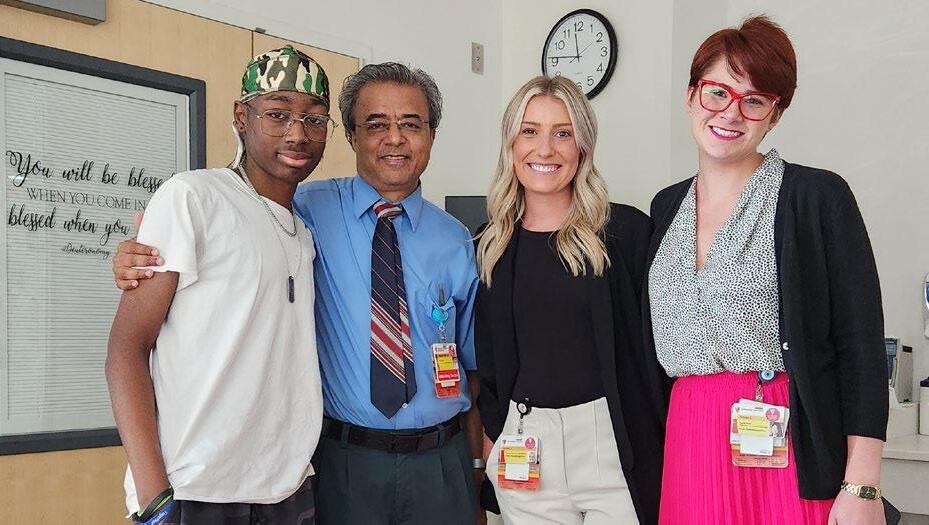
More than 90%
of people with sickle cell disease are Black or African American
and Oncology-Clinical Trials Unit
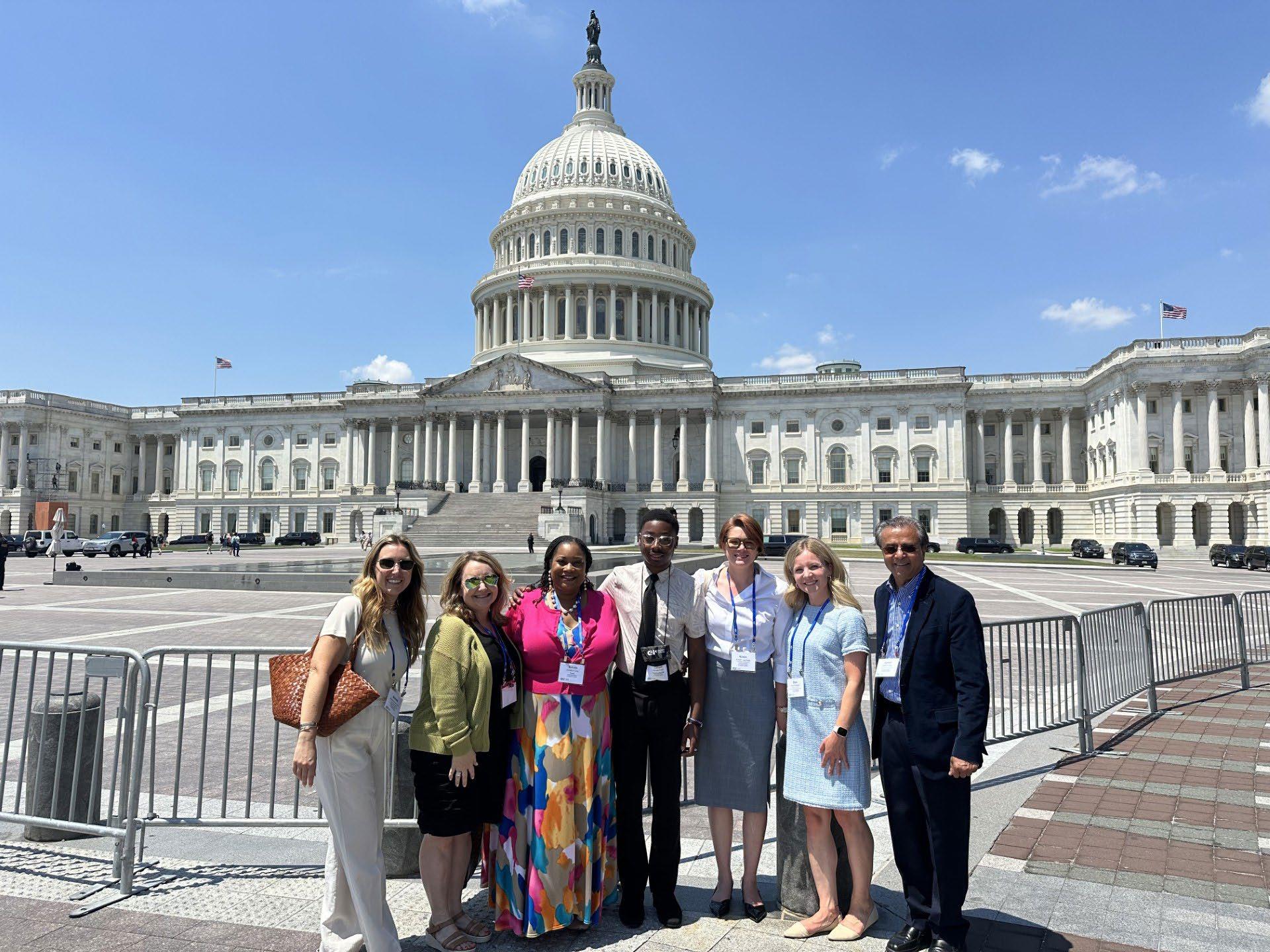

Type 1 diabetes is on the rise among children and teens. The Centers for Disease Control and Prevention’s 2024 National Diabetes Statistics Report puts the current number at 304,000, with significant increases among patients of color over the past decade or so, including Black children and teens. However, existing racial disparities have real-world consequences for Black children and teens with the condition.
The unfortunate reality is that many miss out on the latest technology to manage the disease, and for a variety of reasons. Difficulty obtaining supplies because lack of insurance coverage or high co-pays is one factor. And because type 1 diabetes is less common than type 2 in the Black community, there can be a lack of familiarity and even a reluctance to use a device that’s an outward sign of diabetes. Couple this with a potential lack of trust with the medical team and sometimes even unconscious bias on the part of providers, and diabetes tech usage among Black children and teens is not what it should or could be.
Black children with type 1 diabetes, for example, are nearly three times less likely to start using a continuous glucose monitor within the first year of diagnosis. What’s more, they’re over four times less likely to continue using it. Disparities are similar with insulin pumps.
Fortunately, however, a research team from University Hospitals Rainbow Babies & Children’s is addressing this challenge head-on. Their innovative approach, funded by a prestigious grant from the National Institutes of Health, combines 21st century technology with old-fashioned listening.
How does it work? Through focus groups and one-onone interviews with patients, parents and healthcare workers who treat Black children, the research team has built a diabetes triage dashboard – populated with data from the young patients’ continuous glucose monitors and insulin pumps and linked to each individual patient with a smartphone app. This app sends encouraging messages and communication about what needs improvement that parents, children and teens can respond to. They then receive an
automated response, including a direct email and phone number for the diabetes care team. They can also directly send messages to the diabetes team through the app.
Helping young patients navigate all this technology are community health workers serving as technology coaches.
UH Rainbow endocrinologist and project leader Sarah MacLeish, DO, said she believes this approach can lead to better outcomes for Black children and teens. She and her team will compare this innovative new model to typical care to see what works best.
“I hope we find that our community health worker-dashboard combination helps us to increase technology use. We want our Black patients to use the same amount of technology as all other racial groups. We’re hoping to see at least a 50% improvement, but the ultimate goal would be to make it equal.” – Sarah MacLeish, DO

and
Living with type 1 diabetes as a young adult often means dealing with the financial fallout of the condition on top of its health effects – with few resources as a guide. The health insurance landscape can be confusing, with potentially high out-of-pocket costs and risks for hospitalization. Young adults are also the most likely group to change jobs more than once a year, putting insurance coverage in jeopardy.
“Individuals with type 1 diabetes fear their situation may change and they won’t be able to access health insurance and therefore insulin,” explained nursescientist Julia Blanchette, PhD, who’s also Diabetes Care and Education Specialist at University Hospitals.
To fill this unmet need, Dr. Blanchette has received a grant from the Leona M. and Harry B. Helmsley Charitable Trust to develop and test a type 1 diabetes “financial toolkit.” She and her research team, along with the national nonprofit group The Diabetes Link, have worked over the last year with a community advisory board to develop a toolkit geared for young adults. They’re now beginning to recruit and enroll young adults into a randomized controlled trial from four sites across the U.S.
Importantly, the study team is ensuring that underserved, publicly insured and racially and ethnically diverse populations are included in the study, from both Medicaid-expansion and non-expansion states.
The next step is to make the toolkit available nationwide through The Diabetes Link. UH and The Diabetes Link are committed to making this toolkit free of charge.
Dr. Blanchette said she hopes the toolkit will be the kind of resource she couldn’t find when she was struggling with financial issues as a young adult with type 1 diabetes.
“I found that there was no information on how to navigate health insurance or finances for young adults living with diabetes at all, which was really shocking,” she noted. “It’s an honor to collaborate with colleagues at UH, the type 1 diabetes community members from The Diabetes Link and the community advisory board to help remedy that.”
The goal is to test whether the toolkit improves health insurance literacy, financial stress and diabetes outcomes.


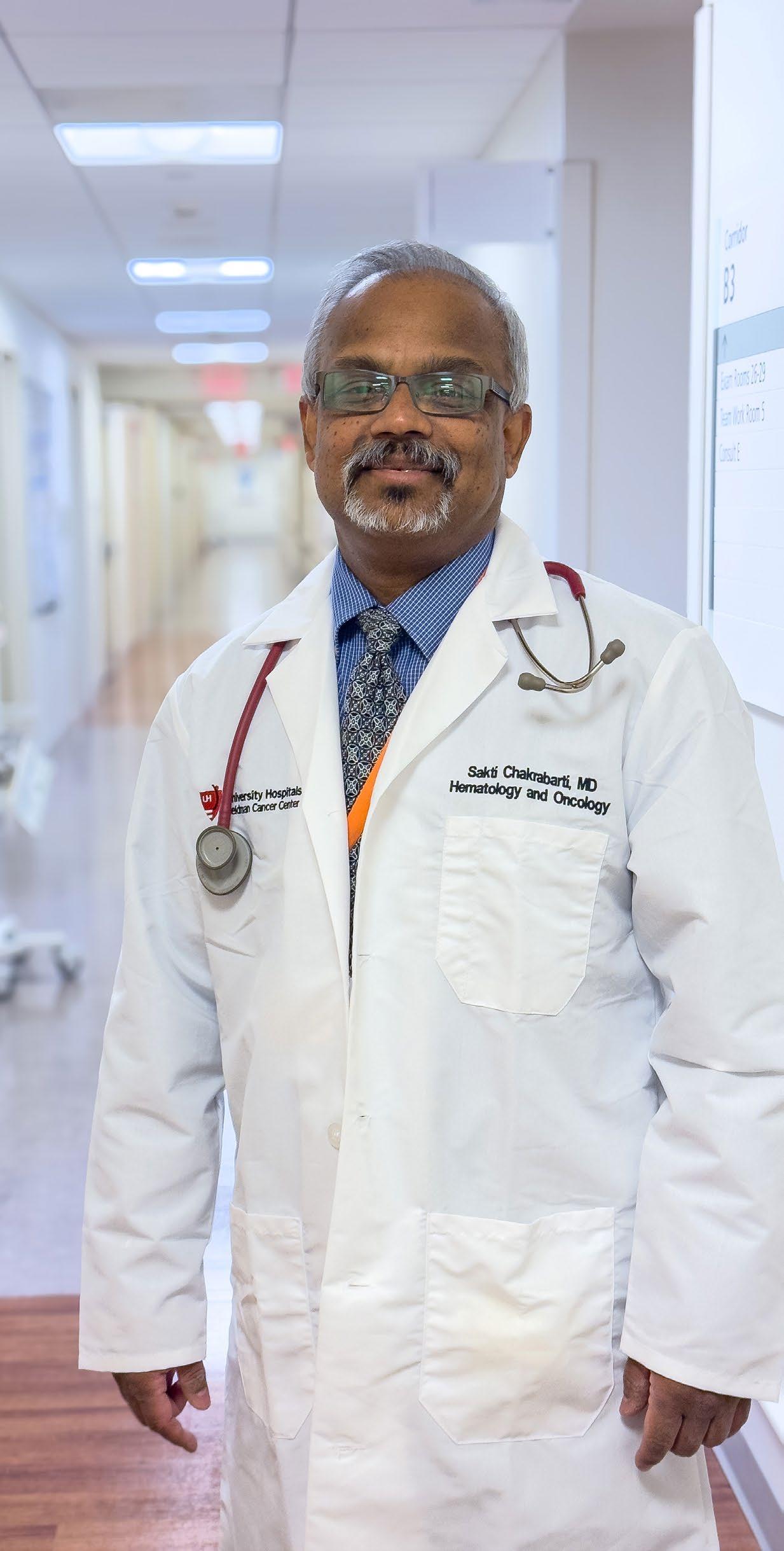
“This is about bringing the right information to the right patient. Information is power, but there’s no power unless we actually use it.”
– Sakti Chakrabarti, MD
Biomarker testing that uses tissue and blood samples to identify genetic clues can open more treatment options for cancer patients. The Equity GI Project led by UH Seidman Cancer Center oncologists specializing in gastrointestinal cancers seeks to improve health literacy and equity among Black patients.
Gastrointestinal cancers encompass a broad swath of the body, from the esophagus, small bowel, pancreas, appendix and hepatobillary system to neuroendocrine systems and the colon and rectum. Yet the understanding of these cancers historically has not factored in the characteristics of the Black patients due to low enrollment in U.S. clinical trials by Black participants, citing social barriers, access and financial issues, plus a well-documented historic dearth of trust in trials.
Sakti Chakrabarti, MD, and Amit Mahipal, MD, Ruth and Donald Goodman Chair in GI Oncology, principal investigators in Equity GI, along with support from an industry sponsor, are intent to increase Black participation in clinical trials.
“Enrollment in clinical trials within the Black population is extremely low, less than 5%, if you look at all clinical trials across the United States,” said Dr. Chakrabarti. “Through Equity GI, we can improve quality of care focusing on Black patients. Our job is to analyze these patients, make treatment recommendations and assist our colleagues to ensure the appropriate biomarkers are tested for evidence-based care.”
Equity GI will ensure Black patients receive biomarker testing for evidence-based care. With initial and followup questionnaires for each patient to establish their level of health literacy, the project will engage patients, guide appropriate treatment plans and provide access to other clinical trials at UH Seidman Cancer Center.
Equity GI aims to enroll at least 200 Black patients over the next two years. If deemed successful, this initiative will be offered to all UH Black patients.
Black residents across Northeast Ohio now have access at University Hospitals to join a study that’s exploring the genetic basis of Parkinson’s disease among people of African descent. Most Parkinson’s studies to date have focused on people of European ancestry, leaving gaps in our knowledge of the disease.
UH is one of just four new sites nationwide added to the Black and African American Connections to Parkinson’s Disease (BLAAC PD) study, run by the Global Parkinson’s Genetics Program (GP2). GP2 is a five-year effort funded by the National Institutes of Health to gather genetic profiles from 150,000 volunteers around the world, drawing on the expertise of a host of international experts. The Michael J. Fox Foundation for Parkinson’s Research is funding the BLAAC PD study.
Most recently GP2 and BLAAC PD collaborators identified a novel gene variant in the GBA1 gene in a cohort predominantly from Nigeria and BLAAC PD enrollees. The GBA1 gene has been identified as a risk factor for Parkinson’s, but this variant was previously unknown. Scientists estimate that a person with two copies of a newly discovered variant are at a roughly 3.5 times higher risk of developing Parkinson’s disease than those with no copies.
Neurologist Camilla Kilbane, MD, Director of the Parkinson’s and Movement Disorder Center, is leading the UH branch of the BLAAC PD study.
“We are happy to be a part of the network of BLAAC PD sites across the U.S. and the GP2 global network in order to expand understanding of Parkinson’s disease within the Black and African American communities,” she said. “We look forward to continuing to contribute to a more holistic, global understanding of Parkinson’s disease by increasing representation in our study populations and learning more about gene changes that may cause the disease.”
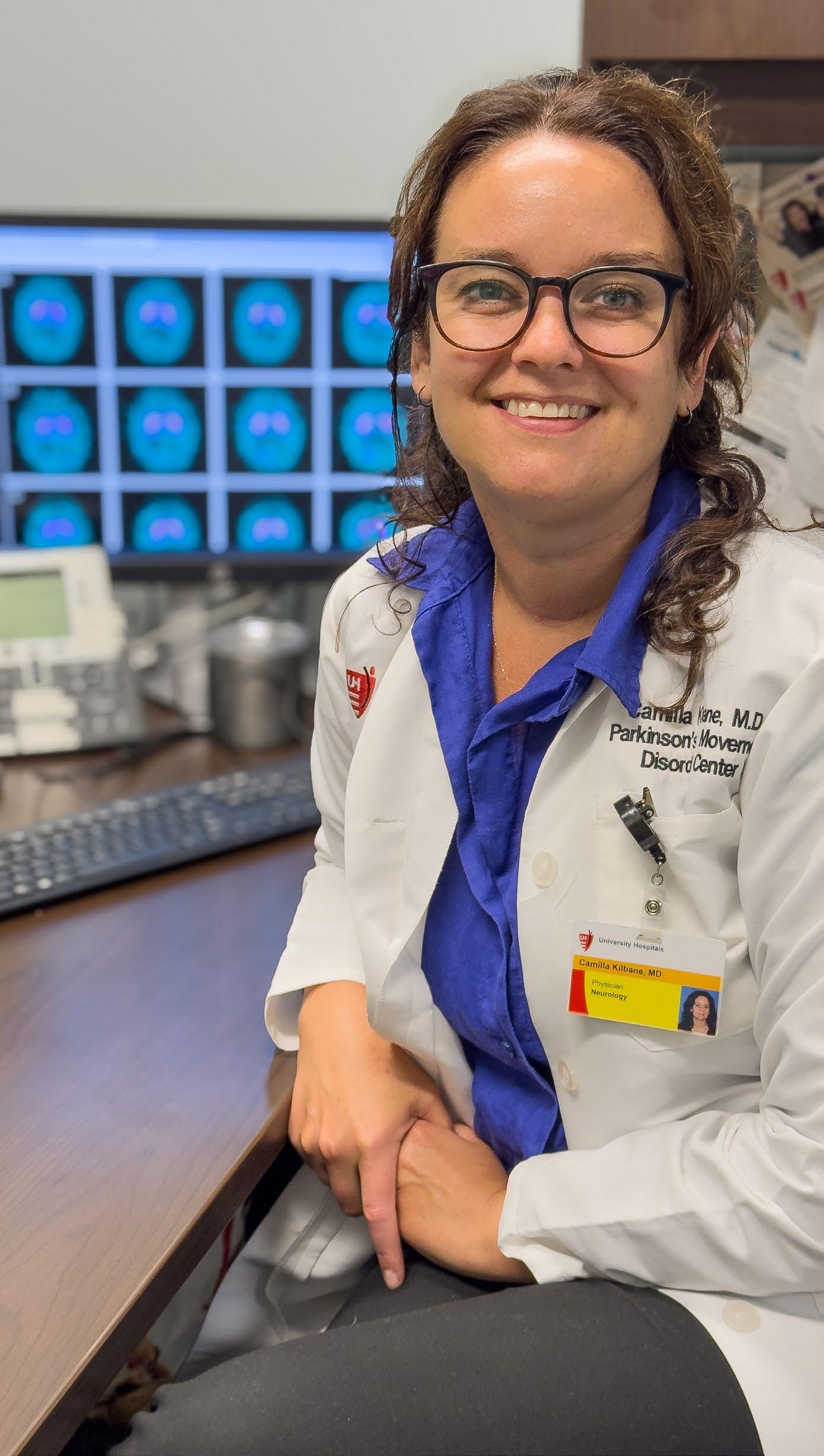
Since 1992, the federal 340B program has provided hospitals with a financial safety net for eligible patients to receive comprehensive care, especially for life-saving medicines that would otherwise be unaffordable.
One of the beneficiaries is the University Hospitals Hemophilia Treatment Center (HTC), which provides life-sustaining clotting factor infusions to patients. Under the 340B savings program, UH incurred a savings of $332 million in 2023, which was able to be reinvested into programs such as the UH HTC, as well as cover reimbursement shortfalls from commercial and government payors.
Patients with hemophilia and other bleeding disorders require these infusions throughout their lives. The clotting factor is very expensive, yet necessary to prevent bleeding complications, so the 340B funds are immensely helpful to patients.
The clotting factor treatment can give hemophilia patients a normal lifespan. But living with the condition can remain stressful for patients, who are careful to avoid injuries that could lead to serious complications, or are discouraged altogether from participating in certain activities such as higher-risk sports.
This lifelong disorder can also make patients – particularly children and young people – feel isolated from others their age.
That’s one reason the Greater Ohio Bleeding Disorders Foundation (GOBDF) uses education and outreach to help them feel part of a larger group, by introducing them to others with bleeding disorders.
The same 340B program that funds the medical treatment for hemophilia – with infusions at the UH HTC or in the patient’s home – also funds outreach that UH and GOBDF collaborate on.
“We had wanted to put on programs ourselves, but it’s hard to find locations and takes a lot of time and energy to set up a program,” explained Susan Hunter, RN, who is UH Senior Hemostasis Nurse Clinician at UH. “We realized that GOBDF does a great job with providing events, and we could help out –perhaps by providing a speaker or participating in other ways.
“When you see patients in clinic, it can be stressful for them, and they are generally focused on the treatment. But at events, people ask more questions, or they might mention some roadblocks they’re facing, or they will let us know what they want to learn more about.”
For example, some patients discover they can benefit from an affordable dental plan that will
ensure they get regular care to avoid dental infections.
Also, it’s recommended that patients have a medical alert tag or bracelet. The cost of obtaining it and the annual fee is covered by the GOBDF, Hunter said.
Other benefits – for children and teens – are just plain fun. But these events continue to provide social and educational opportunities, which include helping fund visits to nearby camps, where they will meet other children with bleeding disorders, while also learning to fish, play golf or practice yoga, noted Tanya Ricchi, executive director of GOBDF.
“Peer-to-peer support can be very helpful,” Ricchi said. “We also offer weekend-long educational programs, wellness initiatives and counseling as well as education scholarships. If they are dealing with barriers in some area, we do what we can to help.”


University Hospitals and Greater Ohio Bleeding Disorders Foundation collaborate to offer education and outreach activities to help children feel less isolated and part of a larger group by introducing them to others with the same disorders in a social setting.
Giving a free book to a child who’s eager to read can expand their world. It turns out the volunteers who help make that donation are changed for the better, too.
Last year, two teams from University Hospitals Home Care used their four hours of paid volunteer time, allotted to them each year through the UH Volunteer Time Off (VTO) program, to sort books in the massive bins at the Cleveland Kids’ Book Bank. VTO’s goal is simple but inspired: To unleash the goodwill of UH caregivers to create a better community, through serving more than 70 nonprofits that share UH’s mission of addressing maternal and child health, well-being and economic opportunity.
The Book Bank’s mission of fostering a love of reading by giving free books to kids who need them – that’s a perfect fit.
“Everybody was interested in this organization because of Kids’ Book Bank’s mission of helping kids build personal libraries of books and advancing their literacy,” said UH Home Care clinical educator Karen Akrish, who organized the outings.
“I hope everybody is taking advantage of the opportunity to give back to the community. It’s a great idea.”
– Joe Green, Physical Therapist

But as the UH Home Care nurses, occupational therapists, physical therapists and others were sorting the chapter books from the picture books, they also enjoyed a rare opportunity to connect with each other. Home care work is by nature often solitary, limited to interactions with the patient in their home.
“It was an enjoyable experience and a great way to get together,” noted occupational therapist Dan Keller. “We don’t have many opportunities, being in the field. I met some people from the office I’ve never seen before.”
The Cleveland Kids’ Book Bank is grateful for UH caregivers spending their time to promote reading to local children.
“None of our work and impact in the community would be possible without our volunteers,” said Devin McNulty-DeMarco, Volunteer Services Manager with Cleveland Kids’ Book Bank. “We are proud to have a strong relationship with University Hospitals and we hope to welcome even more UH volunteers.”
In 2023, UH caregivers logged more than 1,100 volunteer hours in the VTO Program.



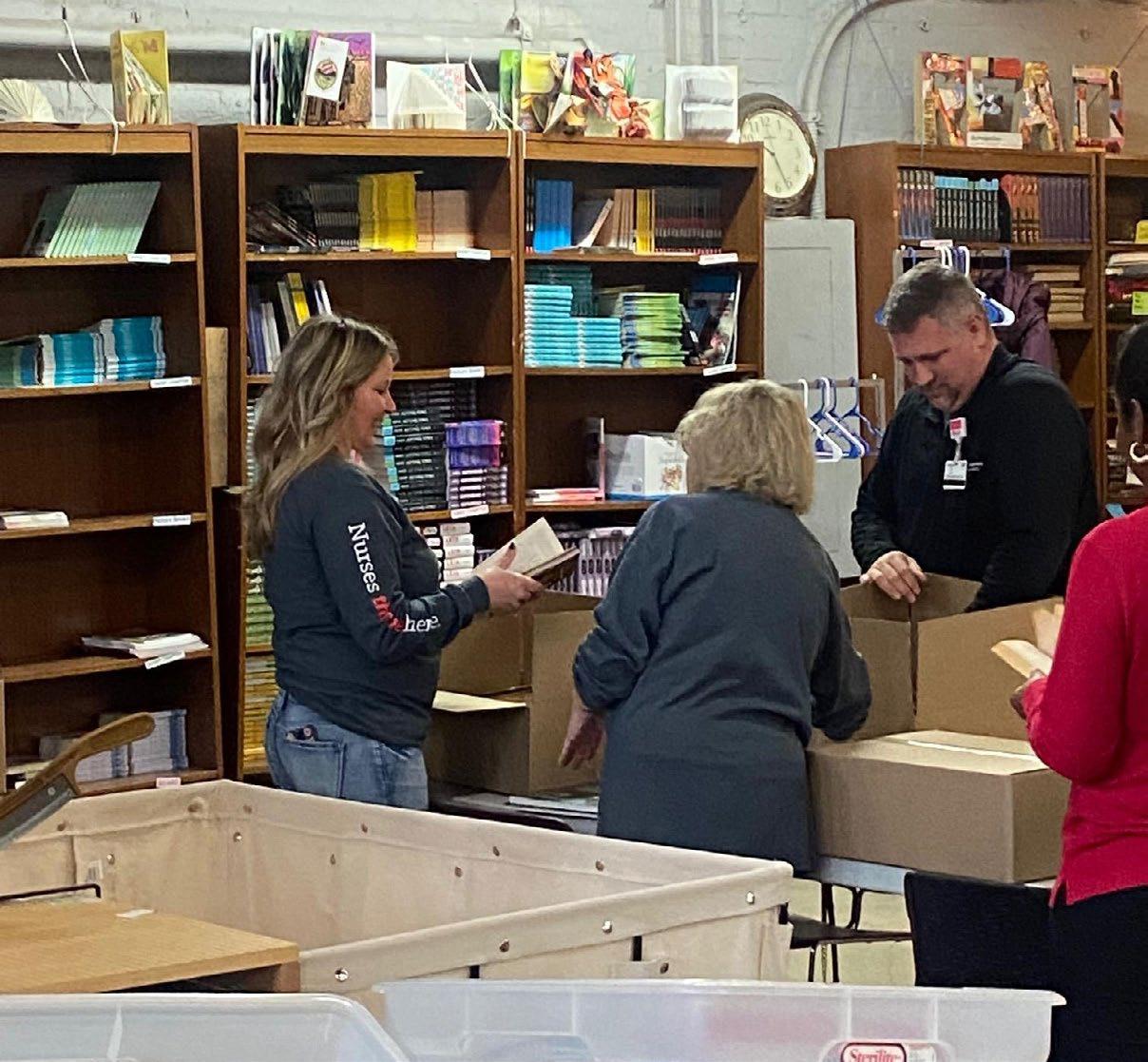
Many caregivers continue to give back outside of work, volunteering their time and expertise with trusted community organizations to help some of our most vulnerable neighbors. It makes a huge difference to these nonprofits.
“UH has partnered with us in so many ways, including to help us shape who we are and what we do,” said Providence House CEO and President Natalie Leek. “Not only do they help us support basic needs, they’re helping us look statewide to expand our impact and help children and families.”
Paul Kostyack’s volunteerism stems from a deep gratitude for the network of friends, family and coworkers who have become like family.
Paul works at UH as Deputy General Counsel, helping the system navigate mergers and acquisitions. But for nearly a decade, he’s also served on the board at Providence House, which provides a safe place for children to live for up to three months while their families navigate crises.
“I’m really lucky,” he says. “I have a network of people I can lean on if something were to happen. But there are so many people who don’t have that. Where would you go? Providence House is providing a safe space for those kids.”
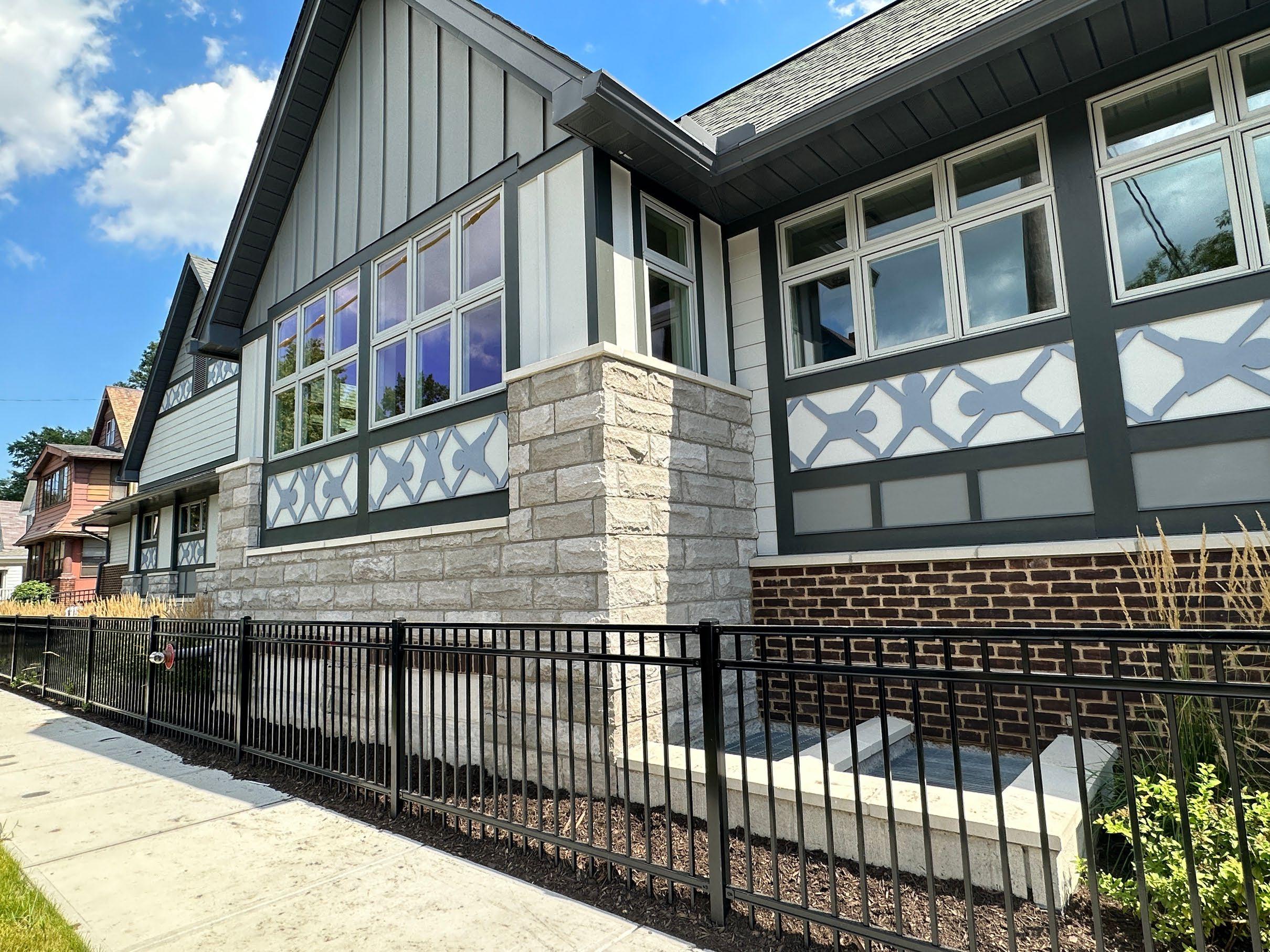

“It’s really a testament to UH’s work and outreach to connect further with our community. This partnership really provides us with more access to resources and we will work together to address common issues.”
– Victor Ruiz, Esperanza CEO
Karina Nieto, MD, came to the United States from Mexico with her family when she was 7. Now, she is Director of UH Seidman Cancer Center’s Brachytherapy, treating women with gynecologic malignancies. It’s been a journey for the girl who didn’t speak English when her family arrived in Colorado.
That’s why Dr. Nieto volunteers as a board member at Esperanza Inc., where she mentors students. The nonprofit provides a variety of services to Northeast Ohio’s Hispanic/Latinx population, including free English-language lessons, tutoring, computers and additional school supplies.
“Esperanza’s values are really aligned with UH’s,” Dr. Nieto said. “Education is a way to change the cycle and make a real, lasting impact.”
Esperanza CEO Victor Ruiz is grateful for Dr. Nieto’s passion, volunteerism and ability to inspire students, and for UH’s willingness to look beyond its immediate neighborhood around University Circle to partner with an organization headquartered on Cleveland’s West Side.




University Hospitals
MEDICAL AND HEALTH CENTERS AND JOINT VENTURES